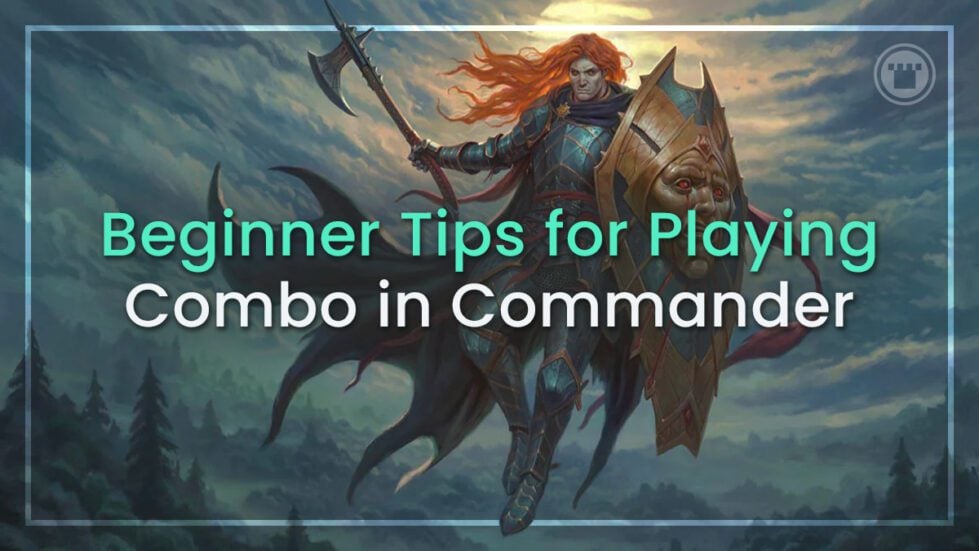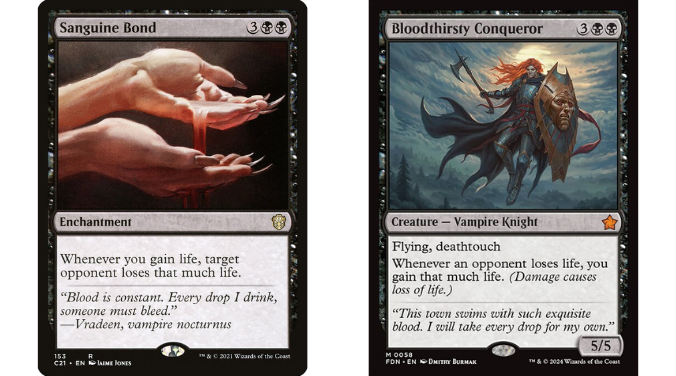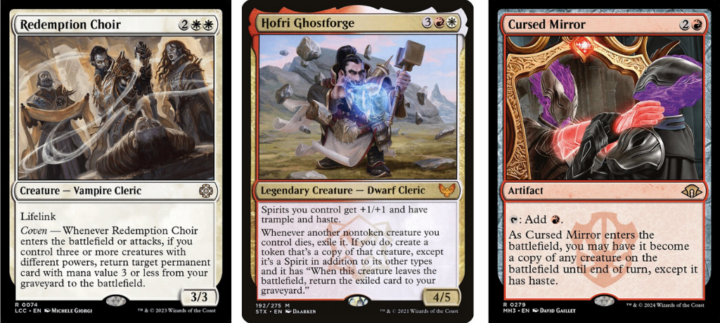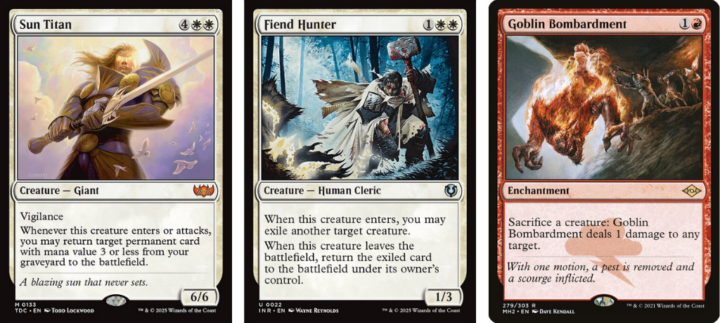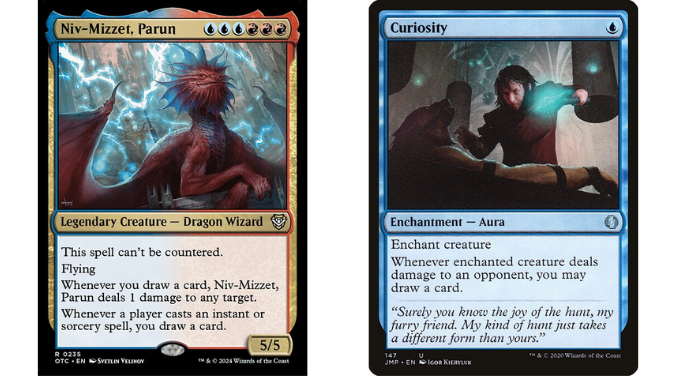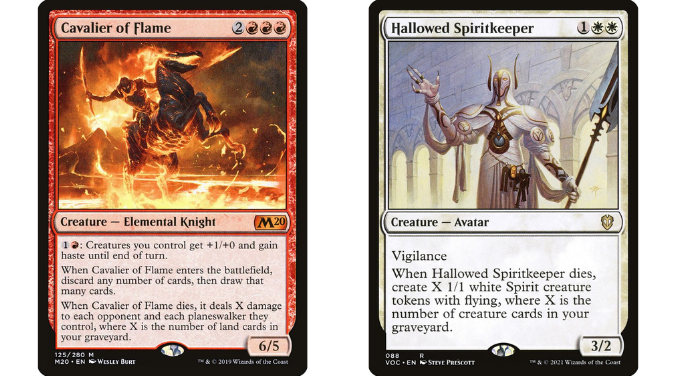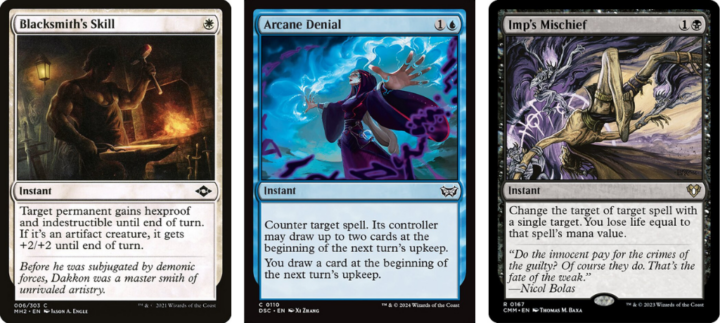Playing a Combo deck in Commander can be a daunting choice for beginners. Combo decks are generally seen as more competitive, more fragile, and requiring a deeper well of gameplay know-how to pull off. If you’re wanting to have a go at playing a Combo deck in Commander for the first time – or you just want a few tips to improve your decks – then we have you covered.
BEGINNER TIPS FOR PLAYING COMBO IN COMMANDER
There are many ways to win a game of Commander. Maybe you have an army of flying creatures, like Dragons or Angels, that can swoop over and defeat enemies. Maybe you’re playing a mill deck, or maybe you have an army of tokens you can sacrifice to drain the life from your opponents bit by bit.
One of the win conditions you can try is Combo. Combo is a way to win the game by repeating a sequence with two or more cards in order to repeat an outcome. That outcome then leads to opponents dying.
Let’s look at an example of an easy to understand Combo in Commander.
Sanguine Bond says that “whenever you gain life, target opponent loses that much life”. Bloodthirsty Conqueror says “whenever an opponent loses life, you gain that much life”. They both trigger each other, and will keep on triggering each other until there are no opponents left to lose life. All you need to do to start the combo is to deal damage to an opponent (to make them lose life) or gain life yourself (to make someone lose life).
This is what is known as an Infinite Combo. It will keep going until the game ends, and requires no further cards or mana to make it work, other than what you invested to start it. Seems like a great one for a Vampires deck, right?!
DETERMINISTIC VS NON-DETERMINISTIC COMBO
You might have heard people refer to combos as Deterministic or Non-Deterministic. Let’s break that down. A combo like the one above, that goes Infinite, is also known as a Deterministic Combo. That means that there is a known and predetermined end point for the combo that plays out. You know what’s going to happen. These types of combos can generally be shortcut to completion provided nobody has interaction to play that would break the loop.
There are other types of combos known as Non-deterministic Combos, too. These combos are not infinite, and have a natural end point, usually because the player who is performing a loop needs more of a resource – whether that be mana, cards, or creatures to sacrifice – than the loop naturally provides during the course of performing it. Non-determinisitic Combos rely on decision trees and probability. You cannot shortcut these loops and must play them out.
It’s quite easy to have Non-deterministic loops crop up in your deckbuilding. For example, in my Hofri Ghostforge Deck, I have Redemption Choir. Redemption Choir can get me a mana value three or less permanent from the graveyard. If I was to sacrifice it, or copy it with Cursed Mirror, while I have Hofri in play, I could feasibly keep repeating the EtB effect – and then also get the attack effect by having the Spirit token copies enjoy haste from Hofri. If some of the things I wanted to bring back were fetchlands, or creatures that make mana, I could feasibly keep this loop going – at least until I run out of mana and ways to reanimate.
It’s a good idea to learn the difference between these types of combo/loop. You should practice playing out Non-deterministic Combo loops because the better you get at recognising them, the faster your gameplay will be. You’ll also get a feel for knowing when you have enough resources to perform such a loop without futzing around and messing up.
A+B PLUS WHAT?
It’s also good to know what type of combos are available, because the number of pieces you need to perform a combo is usually correlated with how powerful it is.
An A+B combo is a combo in its simplest form. You need Card A and Card B to go infinite. The example of Sanguine Bond and Bloodthirsty Conqueror is an A+B combo.
Sometimes you need more pieces to achieve your victory. An A+B+C combo is something like Sun Titan, Fiend Hunter, and Goblin Bombardment. This Combo needs three game pieces to win, which makes it harder to achieve. If instead of Goblin Bombardment you had an Impact Tremors or Terror of the Peaks in play, then you’d need a further card, Card D, to sacrifice the creatures to perform the loop.
When Combos need more pieces, they will generally appear later in the game. The reverse is also true; if your Commander itself is Card A in an A+B Combo, then that’s pretty darn powerful! You always have access to one half of the combo, like Niv-Mizzet, Parun and Curiosity.
Ah, but Kristen! Niv-Mizzet, Parun and Curiosity isn’t a true Infinite.
You’re correct. You only have enough cards in your library to maybe kill two players before you deck yourself. If that’s the case, then you might need to play this one out card by card in order to draw into the spell that finishes off the last player, or that doubles your damage. A determined final opponent might well force you to do this, as it’s advantageous to them for you to kill two other players first before they stop you in your tracks. That’s why it’s really important to learn your combos, the limitations of them, and how to play them out properly.
If you do want to try some combos, what are the best ways to go about it? Here are a few further tips to get you set up.
DECIDE HOW HARD YOU’RE GOING TO GO
First off, you need to decide how hard you’re going to go. Is this in a Bracket 3, mid-powered kind of build, where you don’t want to be winning before Turn 7-8? Well, in that case, you may be better with a combo that involves three or more cards. If you do want to run an A+B combo, it might be best to limit it to one that doesn’t involve the Commander, or to play zero tutors.
On the other hand, if you’re wanting to play at higher power tables, then it might be best to play some tutors to find your pieces, or consider a combo that works with your Commander.
One great resource for finding and learning combos is Commander Spellbook. Go ahead and give it a try.
PLAY ENOUGH REDUNDANCY
If Combo is your main win condition, then you want to consider redundancy.
Take the Vampire life-drain combo we covered above. There are half a dozen more cards that cover those effects available, like Vito, Thorn of the Dusk Rose, Exquisite Blood, and Defiant Bloodlord.
Similarly, one of my win conditions in my Hofri deck is a Non-Deterministic loop of Cavalier of Flame. I spend the game wheeling and discard lands into the yard, and try to win by looping Cavalier a few times with Hofri and cards like Karmic Guide. While there is no redundant effect for Cavalier of Flame, I can still take advantage of the setup I’ve performed to try and win this way, by running a card that also wants a stocked graveyard: Hallowed Spiritkeeper.
Hallowed Spiritkeeper, when played at the same point in the game Cavalier would be dealing 9-13 damage per death trigger, would probably be making me 10+ Spirit tokens. Those Spirit tokens get +1/+1 Trample and Haste from my Commander, meaning two Spiritkeeper death triggers nets me as many as twenty or more EtBs, and 40 hasty damage in the air.
In this way, I have a redundant effect to try and win with other than my Cavalier of Flame.
PLAY PROTECTION SPELLS
The quickest way to lose when playing combo is when your combo is unprotected. All it takes is one piece of interaction, and BOOM!, your hopes and dreams of popping off have been shattered. Redundancy is one way to get around this – taking extra combo pieces can mean that if you lose one, you have another in your back pocket. Whatever color you’re in, you should consider playing some protection for that combo, too.
Each color has tools at their disposal to skirt around removal. Some it is board-wide protection, some can deal with single target removal. Even Red has cards like Tibalt’s Trickery. Just remember that Slip Out the Back and Teferi’s Protection, while great, don’t let you continue your combo that turn.
If you’re playing combo, pack enough protection or counterspells to back it up. Some can be an on-board trick like Selfless Spirit or Benevolent Bodyguard, while others, like Deflecting Swat or Collective Resistance, will be an Instant trick.
PLAY ENOUGH INTERACTION/CONTROL TO GET THERE
One aspect of playing a combo as a win condition that many don’t consider is that they need to have a plan for the early and mid game that helps them get there – wherever there is.
While your early game may consist of playing mana rocks and drawing cards, you’re going to have to be doing something in the window that other decks will be attacking you before you combo off.
That could be making a bunch of tokens to block with, or using utility creatures that help you get set up to chump block with.
You could be on a life-gain approach, gaining incremental or chunks of life to offset damage you might take.
It could be playing a midrange approach, playing creatures with EtB effects that destroy permanents and otherwise throw a spanner in the works for other decks trying to get set up.
It could also be playing plenty of board wipes in order to control the board. Whatever strategy you choose, you’re going to have to have some way to survive until you can enact that combo.
END STEP
Playing Combo in Commander can be an exciting and fun way to play. There are many opportunities to play combos with your favorite Commander to give your deck a little oomph, or add a late-game win condition. I hope these tips have helped you if you’re adopting combo strategies in your deckbuilding.
Are you new to Magic and want more content teaching you about the game? Sign-up for our emails and we’ll make sure you’re in the know about new content!

Kristen is Card Kingdom’s Head Writer and a member of the Commander Format Panel. Formerly a competitive Pokémon TCG grinder, she has been playing Magic since Shadows Over Innistrad, which in her opinion, was a great set to start with. When she’s not taking names with Equipment and Aggro strategies in Commander, she loves to play any form of Limited.

